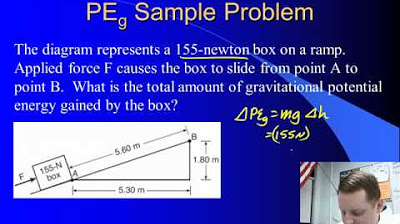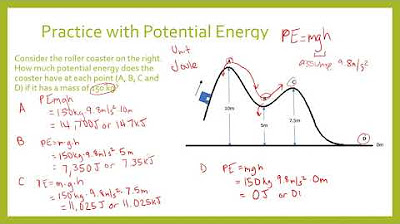Total Energy
TLDRIn this AP Physics essentials video, Mr. Andersen explains the concept of total energy in a system, covering kinetic, gravitational potential, and elastic potential energy. He uses a simulation of a red sphere to demonstrate how these energies convert from one form to another, emphasizing that total energy remains constant despite these conversions. The video also touches on internal energy and illustrates how to calculate different forms of energy with examples, highlighting the interrelation between energy and work.
Takeaways
- 🌟 Total energy of a system is the sum of kinetic, potential, and internal energies.
- 🏀 Kinetic energy is the energy of motion, calculated using mass and velocity (KE = 0.5 * m * v²).
- 🌐 Potential energy can be gravitational (PE = m * g * h) or elastic, depending on the object's position or deformation.
- 🔄 In a perfect system without friction, energy would be conserved and could be converted between forms indefinitely.
- 💥 Friction and other forces can convert energy into other forms, leading to a loss of mechanical energy over time.
- 🔋 Internal energy is the energy associated with the movement of particles within an object, which is difficult to calculate and typically not included in AP Physics calculations.
- 🚀 Work is related to energy; an object with energy has the ability to do work, defined as a force applied over a distance.
- 📈 The conservation of energy principle states that the total energy in a closed system remains constant, despite energy transformations.
- 🔄 The video demonstrates the conversion of elastic potential energy to kinetic energy and vice versa in a simulation.
- 📊 The script provides examples of calculating kinetic and potential energy for a baseball, emphasizing the importance of understanding these concepts for AP Physics.
- 🔧 The concept of rotational kinetic energy is introduced, hinting at its calculation involving rotational inertia and angular velocity.
Q & A
What is the total energy of a system?
-The total energy of a system is the sum of all the energies within that system, including kinetic energy, potential energy, and internal energy.
What types of energy does a moving red sphere with given velocity and stretched spring possess?
-The red sphere possesses kinetic energy due to its motion and elastic potential energy due to the stretched spring. It also has potential gravitational energy because of its position.
What happens to the energies when the red sphere is released?
-When the red sphere is released, the energies convert back and forth between kinetic and potential energies. Elastic potential energy becomes kinetic energy, and vice versa.
How does friction affect the total energy of a system?
-Friction converts some of the mechanical energy (kinetic and potential) into other forms of energy, such as heat. In a real-world scenario with friction, the system will eventually lose energy and come to rest.
What is internal energy?
-Internal energy is the energy associated with the random motion of particles within an object. For example, the molecules in a glass of water have internal energy due to their movement.
How is kinetic energy calculated?
-Kinetic energy is calculated using the formula KE = 0.5 * m * v^2, where m is the mass of the object and v is its velocity.
What factors affect the amount of kinetic energy an object has?
-The amount of kinetic energy an object has depends on its mass and the square of its velocity. Doubling the mass or velocity will double or quadruple the kinetic energy, respectively.
How is gravitational potential energy calculated?
-Gravitational potential energy is calculated using the formula PE = m * g * h, where m is the mass, g is the acceleration due to gravity, and h is the height above the reference point.
What is elastic potential energy and how is it calculated?
-Elastic potential energy is the energy stored in a deformed elastic object, such as a spring. It is calculated using the formula PE = 0.5 * k * x^2, where k is the spring constant and x is the displacement from the equilibrium position.
How can changes in position and frictional interactions affect the total energy of a system?
-Changes in position can lead to conversions between different forms of energy, while frictional interactions can convert mechanical energy into other forms like heat, leading to a decrease in the total mechanical energy of the system over time.
What is the relationship between energy and work?
-Energy is the ability to do work. Work is the application of a force over a distance, and an object with energy has the potential to perform work on another object.
How can you predict the behavior of a system over time?
-By understanding the types of energy present in a system and the interactions between them, one can predict how the total energy will change over time due to factors like position changes and friction.
Outlines
🌟 Introduction to Total Energy Concepts
This paragraph introduces the concept of total energy in a system, explaining the different forms of energy such as kinetic, gravitational potential, and elastic potential energy. It uses a simulation of a red sphere to illustrate the conversion between these energy forms. The paragraph also touches on the idea of internal energy and the expectation in AP Physics to calculate only kinetic and potential energy. The importance of understanding energy conversion and the relationship between energy and work is emphasized, with an example of a car applying force over a distance to demonstrate work.
📚 Calculation of Kinetic and Gravitational Potential Energy
This paragraph delves into the specifics of calculating kinetic and gravitational potential energy. It provides a step-by-step explanation of how to calculate the kinetic energy of a baseball, including the necessary formula and an example calculation. The concept of doubling the mass or velocity and its impact on kinetic energy is also discussed. The calculation of gravitational potential energy is explained with another example involving a baseball at a certain height, and the formula for elastic potential energy is introduced with an example involving a spring and a baseball.
Mindmap
Keywords
💡Total Energy
💡Kinetic Energy
💡Potential Gravitational Energy
💡Elastic Potential Energy
💡Internal Energy
💡Energy Conversion
💡Friction
💡Conservation of Energy
💡Work
💡Gravitational Field Strength
💡Spring Constant
Highlights
Total energy of a system includes kinetic, gravitational potential, and elastic potential energy.
Kinetic energy is the energy of motion and can be converted to other forms of energy.
Gravitational potential energy is due to an object's position in a gravitational field.
Elastic potential energy is stored in a spring when it is stretched or compressed.
Friction and other forces can convert energy from one form to another, affecting the total energy of a system.
In a perfect system without friction, energy would be conserved and could theoretically last forever.
Internal energy refers to the energy of particles within an object as they move around.
AP Physics expects students to calculate kinetic and potential energy, not internal energy.
Kinetic energy can be calculated using the formula KE = 0.5 * m * v^2.
Doubling the mass of an object doubles its kinetic energy; doubling the velocity quadruples it.
Rotational kinetic energy is different from translational and involves the object's mass, rotational inertia, and angular velocity.
Gravitational potential energy is calculated with the formula m * g * h.
Elastic potential energy is calculated using the formula 0.5 * k * x^2, where k is the spring constant and x is the displacement.
Energy conservation is key in understanding the dynamics of physical systems.
Predicting changes in a system's total energy involves considering position changes and frictional interactions.
Understanding energy calculations is crucial for practical applications in physics.
Transcripts
5.0 / 5 (0 votes)
Thanks for rating:





